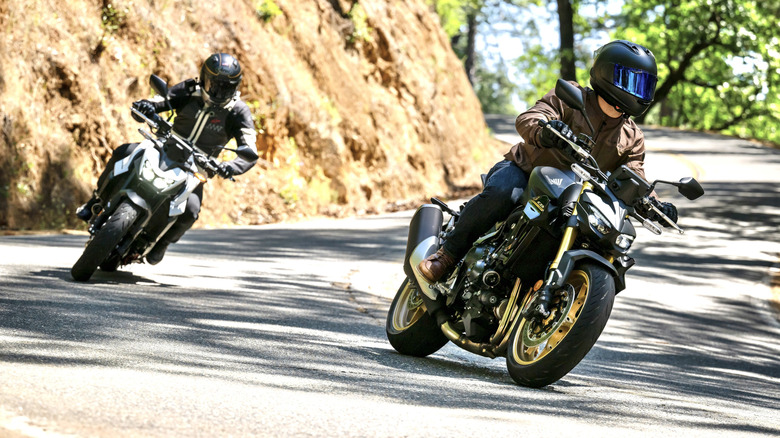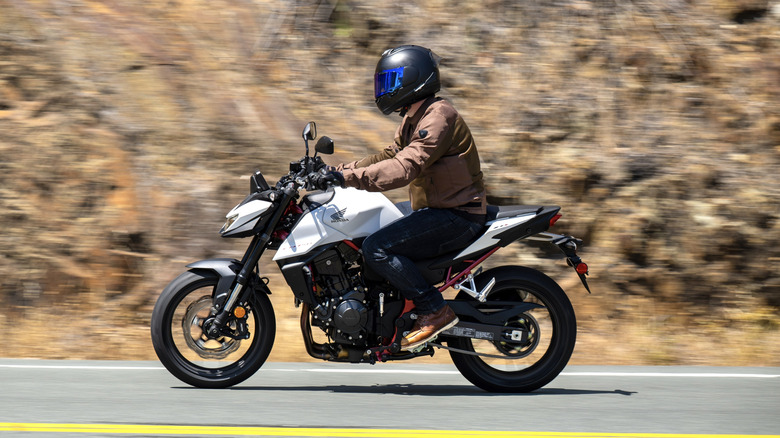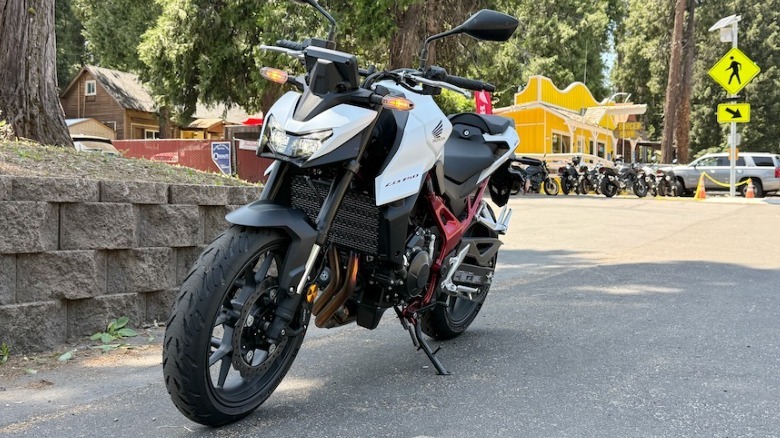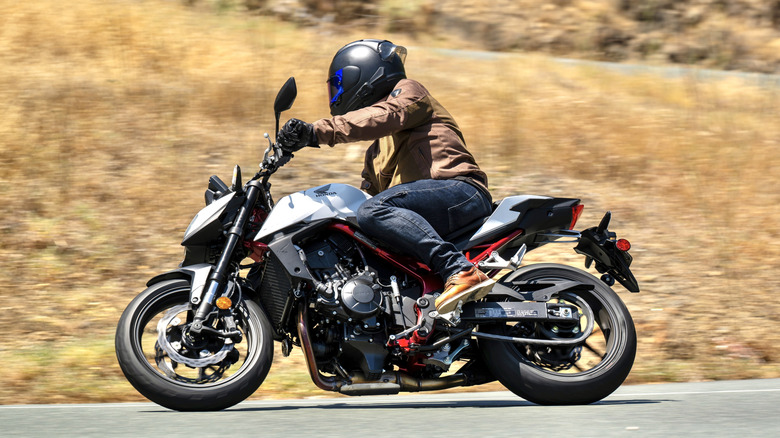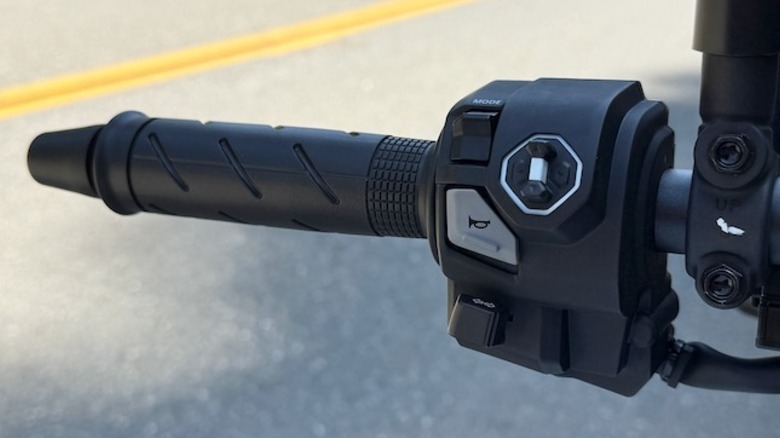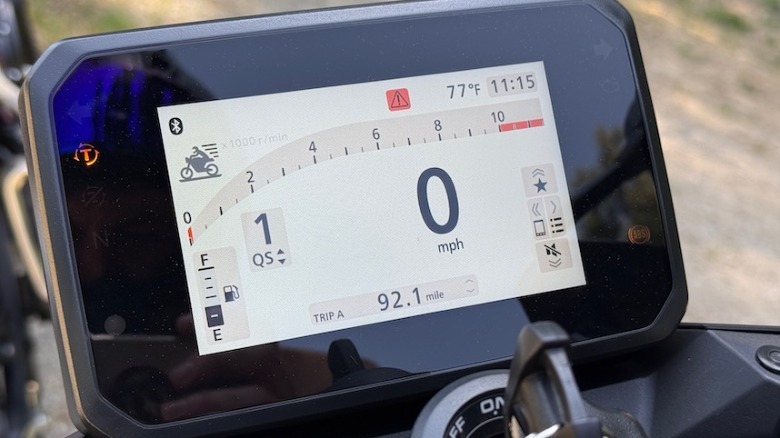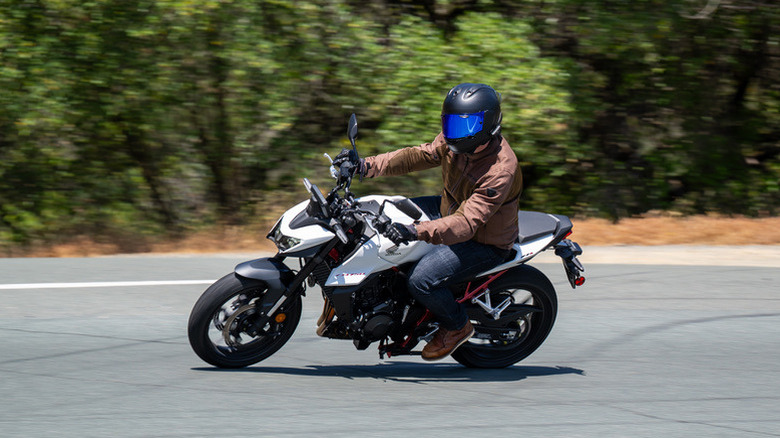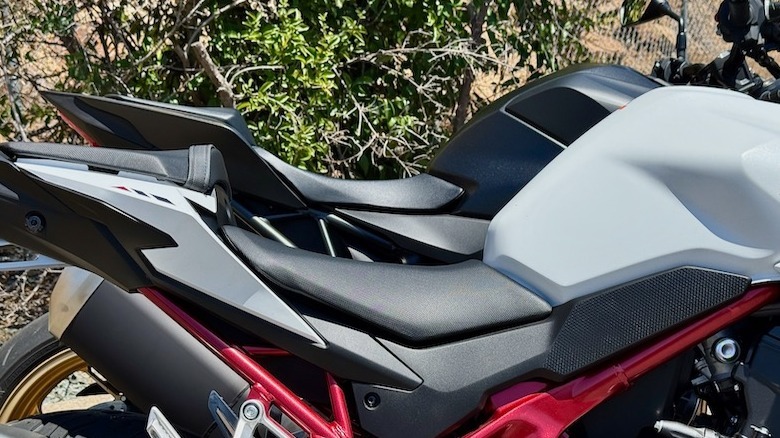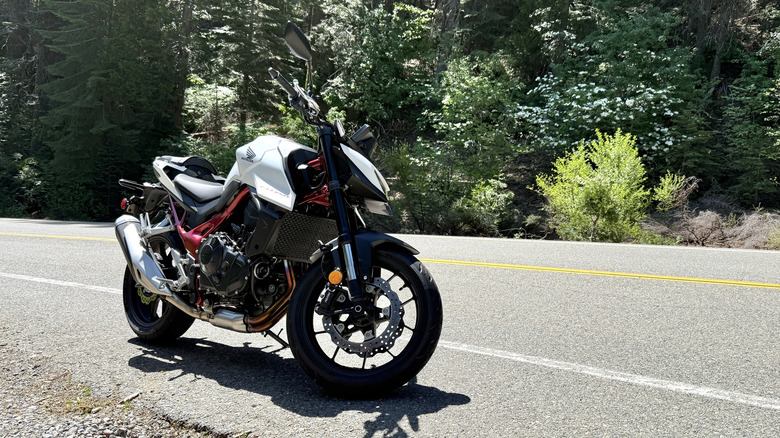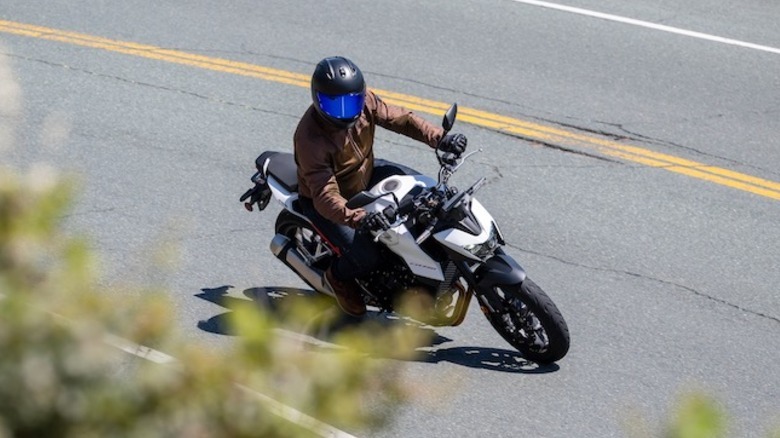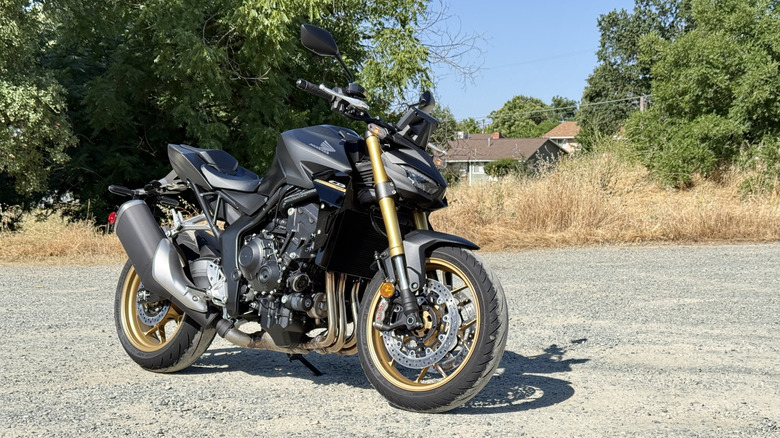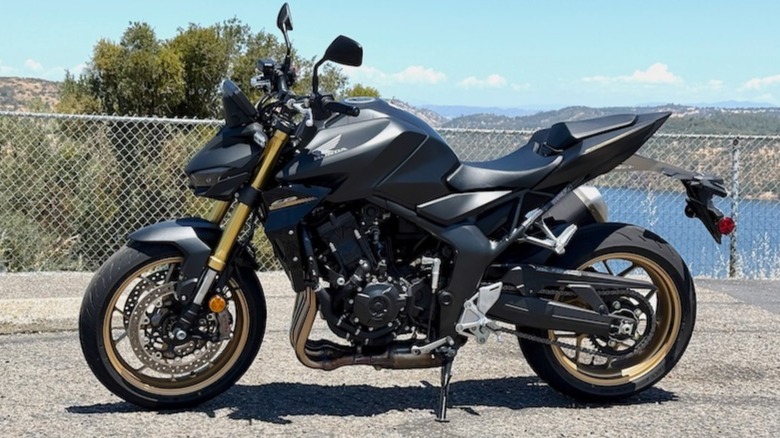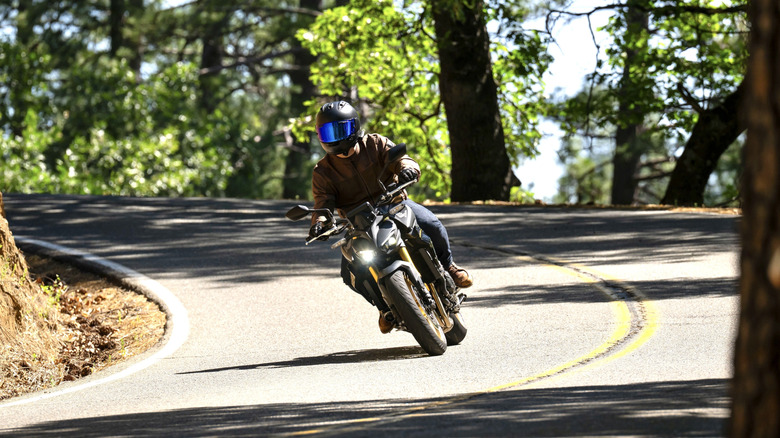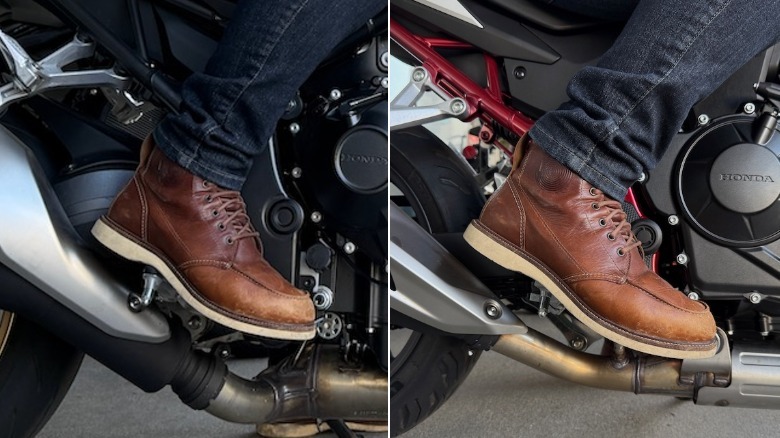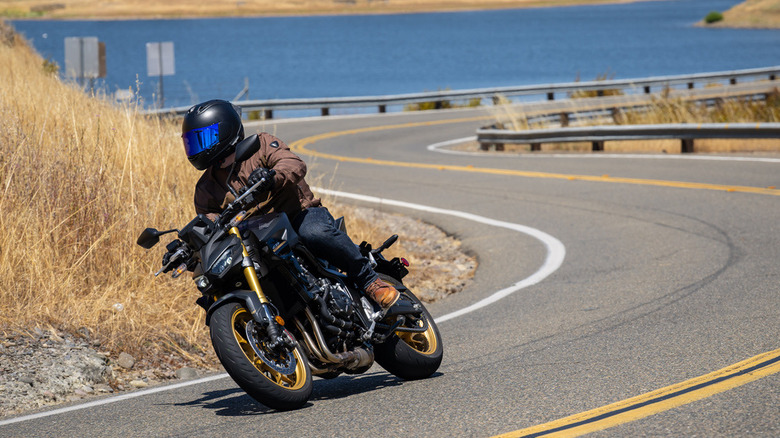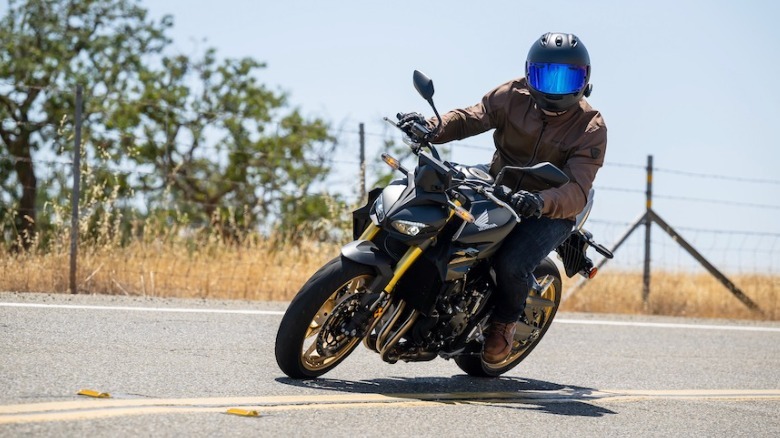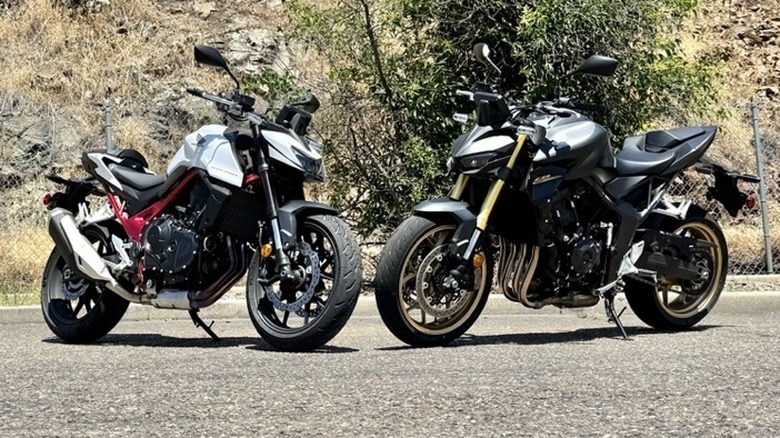2025 Honda CB750 Hornet Vs. CB1000 Hornet SP: After Riding Both, The Winner Is Clear
Honda isn't exactly hurting when it comes to motorcycle selection in the United States. On top of all their plucky mini bikes and a wide variety of available cruisers, there are all sorts of sport bikes up for grabs – almost all of which are guaranteed to raise pulses. We've recently reviewed high-horsepower full-fairing Hondas like the CBR600RR and the CBR1000RR and concluded that they're some of the strongest choices in their respective classes. Meanwhile, more approachable bikes like the CBR300R and CBR500R offer a sporty look and feel for beginner riders.
Even with all that two-wheeled diversity, there is still a small gap worth mentioning in Honda's lineup, however, specifically with naked sport bikes. Somewhere between bikes like the CB500F and the CB1000R, there's some unoccupied space where a few plucky naked sport bikes could challenge a number of established rivals. Enter the CB750 Hornet and the CB1000 Hornet SP.
The Hornet siblings, while new to the United States, have been available for some time in other markets. And each bike offers serious appeal in its own way. The CB750 Hornet offers approachable and practical power, with a competitive price and sharp sensibilities. The CB1000 Hornet SP offers liter-bike levels of grunt along with big upgrades in style. So after testing out both bikes with nearly 400 miles of combined riding, which one did I prefer? Honestly, the answer was a bit of a surprise.
Setting the stage for a showdown
As is the case with most motorcycle introductions from big brands, Honda invited a cadre of test-riders (myself included) out to evaluate the bikes and ride them on picturesque b-roads. The launch, hosted in Northern California, provided me with a chance to ride each bike for a full day – covering about 200 miles of pavement per day. The route included some city streets and a bit of highway commuting, but it mostly consisted of undulating hills and winding b-roads that snake their way west out of Sacramento into the nearby mountains.
Day one for me was spent on the CB750, the smaller of the two new Hornets. From the moment I hopped on and started the CB750, I was impressed. The riding position was excellent for my 5-foot-9 frame and the seat, while narrow, was made with comfortable padding. The thumpy sound of the parallel-twin was more aggressive than I would've expected from a bone-stock bike, and things got even better when the test-ride group jettisoned the trappings of the crowded city.
What kind of power does the smaller Hornet have?
Honda hasn't released power numbers for either bike in the U.S, but there are numbers available for the Hornets as they're configured abroad. The CB750 is rated at 90.5 horsepower (67.5 kW) at 9,500 rpm and 55.3 lb-ft of torque (75 Nm) at 7,250 rpm. Power comes from a 270-degree, 755cc parallel-twin that's connected to a six-speed manual transmission with a standard quick shifter. Rider modes include Standard, Sport, Rain, and two custom User modes.
Power, engine braking, torque control (with integrated wheelie control), and quick-shifter sensitivity can all be set to a rider's preferred levels. I spent most of the day in Sport – it was responsive without being twitchy, and selecting from the pre-set ride modes via the handlebar controls was simple. If you want to ride without traction control though (and allow for some one-wheel action), you'll have to go through the small hassle of a drop down menu that needs to be selected manually every time you start the bike.
The CB750 isn't a tower of power, but it's got more than enough gusto for easy passes on two-lane highways, especially considering its modest curb weight of 422 pounds. Low-RPM torque delivery was excellent and mid-range power on corner exits was easy to apply without feeling like I was going to upset the rear of the bike. Overall, it's a consistent and rewarding experience when you twist the throttle, no matter what the riding scenario is.
Riding position and comfort are top notch on the CB750
Over about 200 miles of riding, most of which was twisty and highly entertaining, I didn't experience discomfort in any of my typical hot spots. With that much riding in one day, I'm typically a bit worse for wear, especially on a sportbike, but that wasn't the case with the CB750. The upright riding position meant that most of my weight was centered over the seat, so there wasn't much weight on my wrists. The light clutch lever and the responsive brake lever didn't require much clamping force either.
The CB750 has a seat height of 31.3 inches which is low enough that most riders should have no problem settling in, even those on the shorter side like myself. What's more, the padding on the standard seat wasn't just comfortable for my first impression, it was forgiving throughout the entire day, as was the suspension.
The CB750's front suspension isn't adjustable, but that's pretty typical for the class. It uses a fixed 41mm Showa front fork that gives the rider 5.1 inches of travel. That's more than enough to soak up most moderate bumps, whether you're canyon carving or commuting. The rear suspension offers adjustable preload via a Showa remote-reservoir shock, also with 5.1 inches of suspension travel.
What the CB750 is up against
Considering its performance, comfort, and equipment, the CB750 is a relative bargain in its class. It has a starting price of $8,599 (including $600 destination fee) which is less than most similarly-powered competitors, and in key rivalries the Honda has both a lower price and more power.
One of the Hornets strongest competitors is the Yamaha MT-07, for instance, which is only working with 689cc's of displacement. It produces a more-modest 68 hp and 46.5 lb-ft, but it weighs a bit less: it's 403 lbs wet, according to Yamaha. The MT-07 has a very similar feature set to the Honda, but with a higher starting price at $9,199 (including $600 destination fee).
The smaller Kawasaki Z650 is a similar story when it comes to power with just 67 hp and 48.5 lb-ft but it does offer a pretty appealing price. The 2025 Z650 ABS models have recently dropped to $8,414 (including $665 destination fee), but a $550 "supply-chain surcharge" may apply depending on your location. Suzuki offers rivals like the SV650 and the GSX-8S that flank the CB750 in terms of price and performance and are also worth considering, but neither quite strikes the same impressive balance as the Honda.
The heart of a CBR1000RR
On day two, I made the switch to the CB1000 Hornet SP. With a wider tank, a wider seat, and a slightly different riding position, it wasn't as immediately comfortable as the CB750, but I wasn't shocked: it's a liter bike after all, with a more aggressive mission statement. Abroad, the CB1000 SP is the higher-spec trim, offering a bit more power and performance than the standard CB1000 model. Here in the U.S. the SP is the only one we're getting though – at least for now.
The CB1000 SP uses Honda's 1,000cc four-cylinder engine, sourced from the 2017 CBR1000RR, but with unique lightweight pistons, model-specific tuning for better mid range power, and its own gearing designed for better acceleration in the middle gears (2 through 5).
According to Honda UK, the CB1000 SP produces 155 hp (115.6 kw) at 11,000 rpm and 78.9 lb-ft (107 Nm) at 9,000 rpm. That's significantly less than the CBR1000RR it's based on (188 hp) but much more power than the CB750 and still thoroughly entertaining. Like the CB750, the 1000 SP gets three different preset rider modes and two customizable modes. With the CB1000 SP, I immediately found Sport mode a bit too sensitive, so I dialed back the engine braking for the duration of the ride. Acceleration was thrilling with a wide open throttle, and less sensitive once I was under way, which meant I could aim for the horizon with a much fuller head of steam.
More performance and more features, but less comfort
The CB1000 SP was an absolute joy to ride, with light inputs for its size and an agile nature, but it's more aggressive and therefore more taxing. Similar to my day-one riding experience, day two included about 200 miles of mixed riding and the CB1000 SP's firm seat took a toll. The CB1000 SP's front and rear suspension both have adjustable preload, rebound, and compression, so the ride is more adjustable than the CB750 but the ride was still rough, no matter how much fiddling with the settings I did.
The CB1000's claimed curb weight of 465 lbs isn't exactly heavy, but it's more mass to wrangle for a spirited day of riding. To top it all off, the slightly-higher seat sits at 31.9 inches, making it ever-so-slightly more difficult to flat-foot at stop lights.
The CB750's riding position is also a bit better than the 1000. With my feet placed in the same position on both bikes (the 1000 is on the left, the 750 is on the right), the rear of my boot hit the large muffler on the 1000 several times during my ride. The 750, with its smaller exhaust (or maybe just based on the location of the foot pegs) didn't have that problem. These are small issues, and ones that most riders in the market for a liter bike could probably overcome, but for me the extra fatigue left a strong impression.
Strong rivals for the CB1000 SP
Like the CB750, the CB1000 SP has some pretty stiff competition from rivals like Yamaha, Kawasaki, and Suzuki. All four offer impressive power for the money. The CB1000 SP has an MSRP of $11,774 (including $775 destination fee). The three-cylinder Yamaha MT-09 undercuts the Honda by a few hundred dollars, checking in at $11,424 (including $625 destination fee) but like the MT-07, it's down on power: just 117 hp up against the Hornet's 155. You could always upgrade to the MT-09 SP or the spicier MT-10 if you were looking to buy a Yamaha with more grunt, but both cost several thousand dollars more than a CB1000 SP.
The new Kawasaki Z900 offers similar features and pricing to the CB1000, and I'm excited to ride one soon, but top versions of the Z900 climb as high as $12,664 (including $815 destination fee) and offer 123 hp. The Suzuki GSX-S1000 is possibly the most competitive of the naked liter-bike bunch, and it checks in at $12,439 (including $530 destination fee) with 152 hp – a near perfect match for the Honda and a rival that I'm particularly eager to test out.
The Verdict: Which is the Hornet to pick
With comfort, pricing, and performance considerations all taken into account, I had a clear winner after two days on the road. The four-cylinder engine sourced from the CBR1000RR is a real treat in something as affordable as the CB1000 Hornet SP, and it's a compelling choice in its segment, but in a Hornet-on-Hornet battle, it doesn't come out on top.
The CB750 Hornet is a better daily rider, a stronger value in its segment, and a more approachable bike for the masses. Riders who have decided to graduate from their beginner 300 or 500cc bikes could easily hop on the CB750 without intimidation or fear, but expert riders could just as easily enjoy it. Make no mistake, the CB1000 Hornet SP is still an excellent bike, and one I'm glad Honda has brought to the U.S., but the CB750 is quick, easy to ride, and it's the bike I'd prefer between the two for a wider variety of riding purposes.
